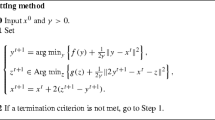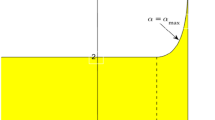Abstract
We adapt the Douglas–Rachford (DR) splitting method to solve nonconvex feasibility problems by studying this method for a class of nonconvex optimization problem. While the convergence properties of the method for convex problems have been well studied, far less is known in the nonconvex setting. In this paper, for the direct adaptation of the method to minimize the sum of a proper closed function g and a smooth function f with a Lipschitz continuous gradient, we show that if the step-size parameter is smaller than a computable threshold and the sequence generated has a cluster point, then it gives a stationary point of the optimization problem. Convergence of the whole sequence and a local convergence rate are also established under the additional assumption that f and g are semi-algebraic. We also give simple sufficient conditions guaranteeing the boundedness of the sequence generated. We then apply our nonconvex DR splitting method to finding a point in the intersection of a closed convex set C and a general closed set D by minimizing the squared distance to C subject to D. We show that if either set is bounded and the step-size parameter is smaller than a computable threshold, then the sequence generated from the DR splitting method is actually bounded. Consequently, the sequence generated will have cluster points that are stationary for an optimization problem, and the whole sequence is convergent under an additional assumption that C and D are semi-algebraic. We achieve these results based on a new merit function constructed particularly for the DR splitting method. Our preliminary numerical results indicate that our DR splitting method usually outperforms the alternating projection method in finding a sparse solution of a linear system, in terms of both the solution quality and the number of iterations taken.
Similar content being viewed by others
Notes
We note that the assumption where f has a Lipschitz continuous gradient is commonly used in the literature of first-order methods; see for example, [5, Section 5].
We note that, a more general and informative statement that applies to the square distance function of a possibly nonconvex but prox-regular set can be found in [29, Theorem 1.3].
We also solved a couple instances using directly a small \(\gamma < \gamma _0\) in the DR splitting method. The sequence generated tends to get stuck at stationary points that are not global minimizers.
We report \(\frac{1}{2} d_C^2(z^t)\) for DR splitting, and \(\frac{1}{2} d_C^2(x^t)\) for alternating projection.
The two thresholds are different and hence \(\mathrm{succ} + \mathrm{fail}\) is not necessarily 50. We set different thresholds so as to see if it is easy to determine whether the method has got stuck at stationary points that are not global minimizers.
References
Aragón, A.F., Borwein, J.M.: Global convergence of a non-convex Douglas–Rachford iteration. J. Global Optim. 57, 1–17 (2012)
Aragón, A.F., Borwein, J.M., Tam, M.K.: Douglas–Rachford feasibility methods for matrix completion problems. ANZIAM J. 55, 299–326 (2014)
Aragón, A.F., Borwein, J.M., Tam, M.K.: Recent results on Douglas–Rachford methods for combinatorial optimization problems. J. Optim. Theory Appl. 163, 1–30 (2014)
Attouch, H., Bolte, J., Redont, P., Soubeyran, A.: Proximal alternating minimization and projection methods for nonconvex problems. An approach based on the Kurdyka–Lojasiewicz inequality. Math. Oper. Res. 35, 438–457 (2010)
Attouch, H., Bolte, J., Svaiter, B.F.: Convergence of descent methods for semi-algebraic and tame problems: proximal algorithms, forward–backward splitting, and regularized Gauss–Seidel methods. Math. Program. 137, 91–129 (2013)
Bauschke, H.H., Borwein, J.M.: On the convergence of von Neumann’s alternating projection algorithm for two sets. Set-Valued Anal. 1, 185–212 (1993)
Bauschke, H.H., Borwein, J.M.: On projection algorithms for solving convex feasibility problems. SIAM Rev. 38, 367–426 (1996)
Bauschke, H.H., Combettes, P.L.: Convex Analysis and Monotone Operator Theory in Hilbert Spaces. Springer, Berlin (2011)
Bauschke, H.H., Noll, D.: On the local convergence of the Douglas–Rachford algorithm. Arch. Math. 102, 589–600 (2014)
Bolte, J., Daniilidis, A., Lewis, A.: The Łojasiewicz inequality for nonsmooth subanalytic functions with applications to subgradient dynamical systems. SIAM J. Optim. 17, 1205–1223 (2007)
Bolte, J., Daniilidis, A., Lewis, A., Shiota, M.: Clarke subgradients of stratifiable functions. SIAM J. Optim. 18, 556–572 (2007)
Borwein, J.M., Li, G., Yao, L.J.: Analysis of the convergence rate for the cyclic projection algorithm applied to basic semialgebraic convex sets. SIAM J. Optim. 24, 498–527 (2014)
Combettes, P.L., Pesquet, J.-C.: A Douglas–Rachford splitting approach to nonsmooth convex variational signal recovery. IEEE J. Sel. Top. Signal Proces. 1, 564–574 (2007)
Douglas, J., Rachford, H.H.: On the numerical solution of heat conduction problems in two or three space variables. Trans. Am. Math. Soc. 82, 421–439 (1956)
Eckstein, J., Bertsekas, D.P.: On the Douglas–Rachford splitting method and the proximal point algorithm for maximal monotone operators. Math. Program. 55, 293–318 (1992)
Gandy, S., Recht, B., Yamada, I.: Tensor completion and low-\(n\)-rank tensor recovery via convex optimization. Inverse Probl. 27, 025010 (2011)
Gong, P., Zhang, C., Lu, Z., Huang, J., Ye, J.: A general iterative shrinkage and thresholding algorithm for non-convex regularized optimization problems. In: The 30th International Conference on Machine Learning (ICML 2013)
He, B., Yuan, X.: On the \(O(1/n)\) convergence rate of the Douglas–Rachford alternating direction method. SIAM J. Numer. Anal. 50, 700–709 (2012)
Hesse, R., Luke, D.R.: Nonconvex notions of regularity and convergence of fundamental algorithms for feasibility problems. SIAM J. Optim. 23, 2397–2419 (2013)
Hesse, R., Luke, D.R., Neumann, P.: Alternating projections and Douglas–Rachford for sparse affine feasibility. IEEE Trans. Signal. Proces. 62, 4868–4881 (2014)
Lewis, A.S., Luke, D.R., Malick, J.: Local convergence for alternating and averaged nonconvex projections. Found. Comput. Math. 9, 485–513 (2009)
Lewis, A.S., Malick, J.: Alternating projections on manifolds. Math. Oper. Res. 33, 216–234 (2008)
Li, G., Mordukhovich, B.S., Pham, T.S.: New fractional error bounds for polynomial systems with applications to Hölderian stability in optimization and spectral theory of tensors. Math. Program. 153, 333–362 (2015)
Lions, P.-L., Mercier, B.: Splitting algorithms for the sum of two nonlinear operators. SIAM J. Numer. Anal. 16, 964–979 (1979)
Lu, Z., Zhang, Y.: Sparse approximation via penalty decomposition methods. SIAM J. Optim. 23, 2448–2478 (2013)
Luke, D.R.: Finding best approximation pairs relative to a convex and a prox-regular set in Hilbert space. SIAM J. Optim. 19, 714–739 (2008)
Patrinos, P., Stella, L., Bemporad, A.: Douglas–Rachford splitting: complexity estimates and accelerated variants. In: Proceedings of the 2014 IEEE 53rd Annual Conference on Decision and Control (CDC), pp. 4234–4239. IEEE, Los Angeles, CA (2014)
Phan, H.: Linear convergence of the Douglas–Rachford method for two closed sets. Optimization. arXiv:1401.6509
Poliquin, R.A., Rockafellar, R.T., Thibault, L.: Local differentiability of distance functions. Trans. Am. Math. Soc. 352, 5231–5249 (2000)
Rockafellar, R.T., Wets, R.J.-B.: Variational Analysis. Springer, Berlin (1998)
Sun, D., Toh, K.-C., Yang, L.: A convergent 3-block semi-proximal alternating direction method of multipliers for conic programming with 4-type of constraints. SIAM J. Optim. 25, 882–915 (2015)
Zeng, J., Lin, S., Wang, Y., Xu, Z.: \(L_{1/2}\) regularization: convergence of iterative half thresholding algorithm. IEEE Trans. Signal Process. 62, 2317–2329 (2014)
Acknowledgments
We would like to thank the two anonymous referees for their comments that helped improve the manuscript.
Author information
Authors and Affiliations
Corresponding author
Additional information
Guoyin Li was partially supported by a research Grant from Australian Research Council. Ting Kei Pong was supported partly by a research Grant from Hong Kong Polytechnic University.
Rights and permissions
About this article
Cite this article
Li, G., Pong, T.K. Douglas–Rachford splitting for nonconvex optimization with application to nonconvex feasibility problems. Math. Program. 159, 371–401 (2016). https://doi.org/10.1007/s10107-015-0963-5
Received:
Accepted:
Published:
Issue Date:
DOI: https://doi.org/10.1007/s10107-015-0963-5




